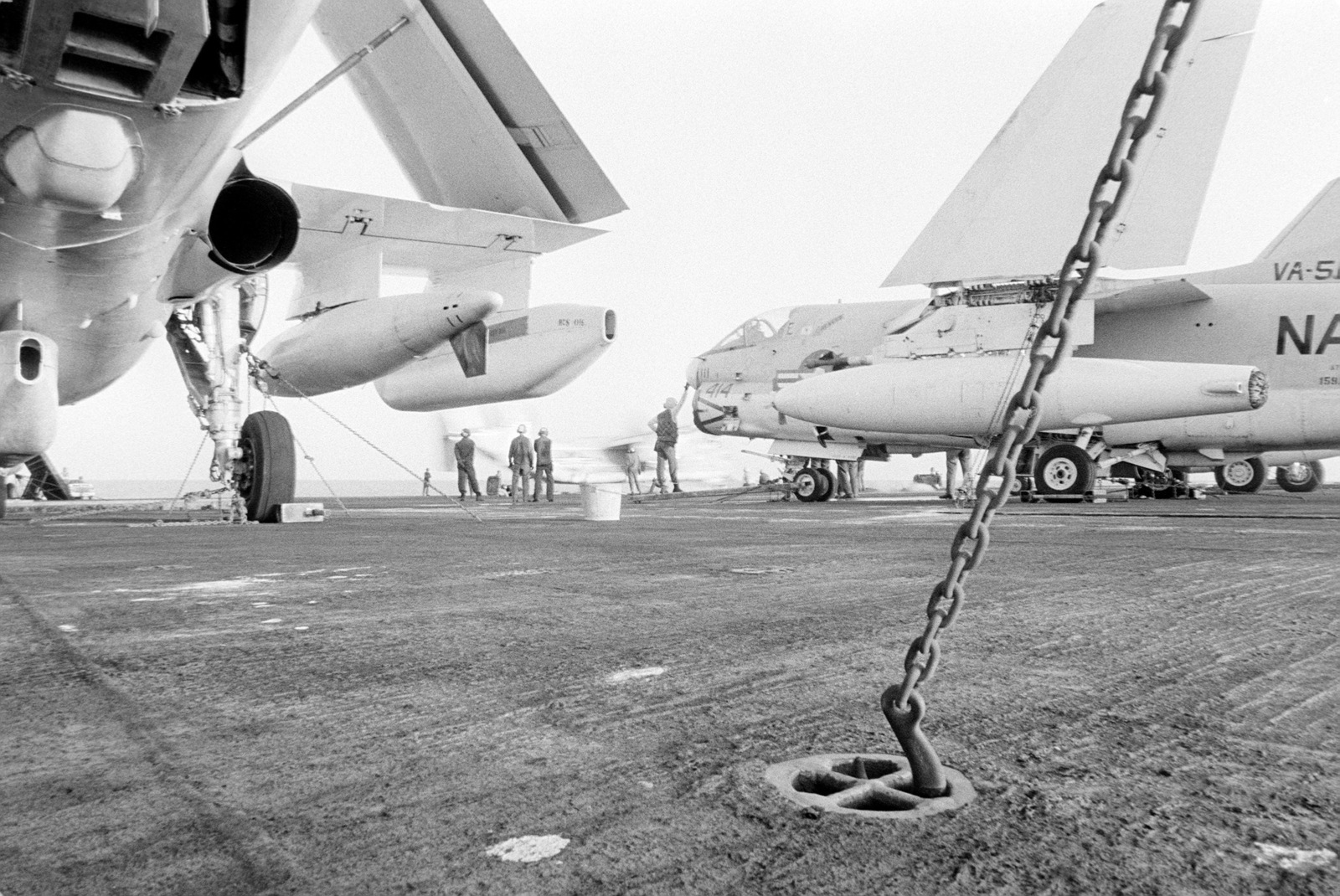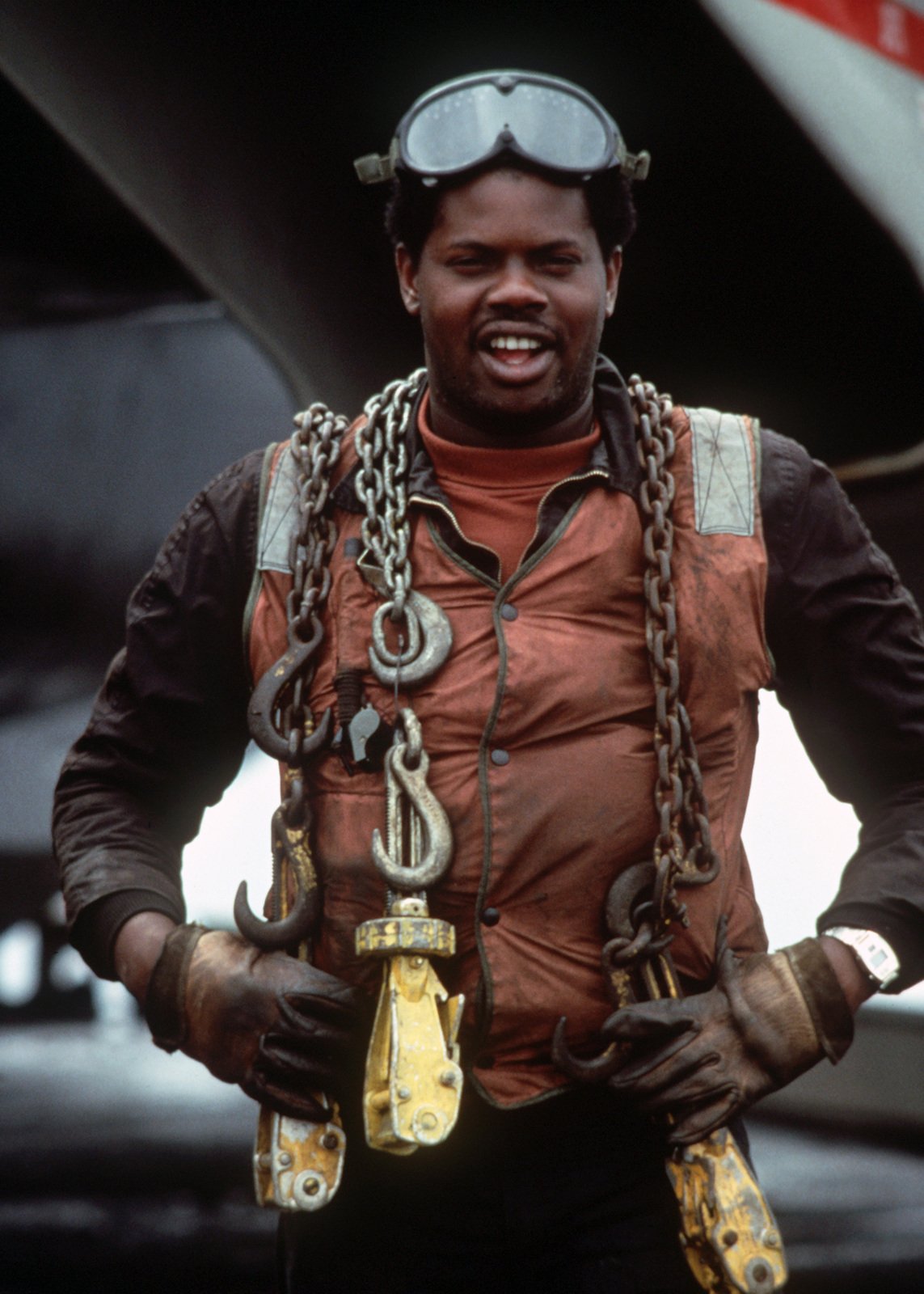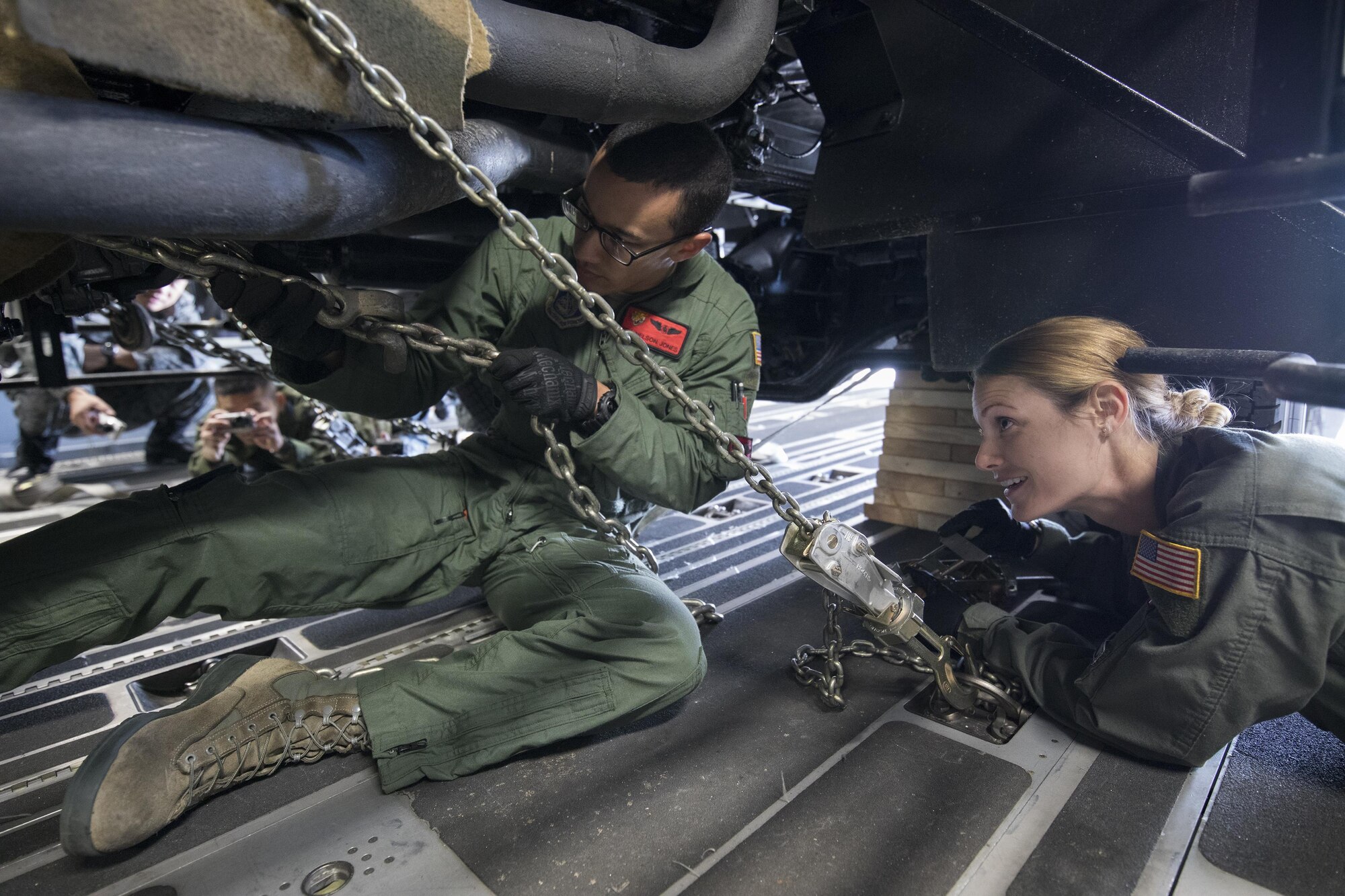Aircraft Tie Down Chains - Temporarily out of stock. Order to get in line while promotions last. The date of future arrival is unknown.
1/48 US Navy Aircraft Construction and Assembly and Socket Pad Eye for Aircraft Carriers and Amphibious Ships.
Aircraft Tie Down Chains

Skill 2 kits require runners to use plastic model assembly techniques, such as cutting out parts, cutting or sanding door jambs (where the part joins the runner). Some kits at this level also provide stickers for certain signs. Most 2nd kits don't require cement or paint, but read the additional information provided to be sure. To finish off the Level 2 kit nicely, you'll need plastic nippers to cut the parts from the runners and a good file, sandpaper, or hobby knife to clean up the doors. In some cases, a couple of pieces make it easier to apply stickers.
A Flight Deck Crewman Stands By With Aircraft Tiedown Chains Draped Over His Shoulders On The Flight Deck Of The Nuclear Powered Aircraft Carrier Uss Theodore Roosevelt (cvn 71)
Most adults with no prior modeling experience will have no difficulty completing the Level 2 skill set. Parents will probably want to help young children with this level of kit if they have never built before.
Kits rated Skill Level 3 are traditional model kits that require all modeling skills. This involves cutting the parts of the runners and cutting or sanding them before use,
To properly complete a Level 3 kit, you will need at least basic modeling, including plastic nippers, hobby knife, file and/or sandpaper, plastic cement, instant (cyanoacrylate) cement (rubber, soft vinyl, or metal parts), and brushes. paint, paint, thinner and masking tape, eraser and softener, including for applying decals to difficult areas.
Kits in this class are not suitable for small children without parental supervision. Adults who have never completed a plastic model kit before may want to read one of the excellent modeling guides available at most hobby shops before attempting to build one of these kits.
Aircraft N13312 (2006 Cessna 172s C/n 172s10401) Photo By Jeremy Barton (photo Id: Ac1162034)
Mastery Level 3 kits make up a large part of our catalog. Most traditional plastic model kits fall into this category.
The kits we rate as Skill Level 4 are just as important as Modeling Techniques and Skill Level 3. However, these kits include smaller parts using multiple materials (rubber, white metal, photos, etc.). .) the need to make some changes to the parts before completing and using the kit, such as resizing, drilling holes, etc.
To properly complete a level 4 set, you'll want to have level 3 skill sets. Additionally, a pin vise (hand-held drill) and plastic glass will help if necessary.

Sets in this class are generally not suitable for small children. Children under 14, even experienced children, can struggle with such a kit if they try it alone. Adults who have not completed a plastic model kit before are advised to avoid the level 4 or 5 skill kit until they gain modeling experience by working with something more challenging.
Aircraft Ground Handling
Examples of Skill Level 4 kits are automotive or aircraft injection-plastic kits that contain rubber or white metal modification parts, or kits that require cutting or other modification of existing parts. Multi-part resin figure kits will also fall into this category.
The kits we rate as Level 5 require the same modeling techniques and tools as Level 3 and Skill Level 4. Additionally, skill level 5 kits are often made entirely of materials other than plastic, which may contain very small parts. , often requires extensive modification of parts to complete, and in some cases instructions are not provided in English (only in Japanese). Correct assembly of these latter types of kits requires a degree of engineering by the modeler as well as extensive test fit.
The tools and equipment required to complete these class sets are unchanged from skill level 4.
Sets in this class are generally not suitable for small children. Children under 14, even experienced children, may struggle with such a kit if they try it on their own, and it may not even help. Adults who have never completed a model kit before are advised to avoid a level 4 or 5 skill kit until they gain modeling experience by working with something more challenging.
Wb11251 (use: 11251) Cessna Cargo Anchor Tie Down (m22)
Examples of kits in this class include metal kits of racing cars and ships, accessory parts for such kits, and advanced resin kits of fantasy objects.
For injection-molded kits, use a clear adhesive cement specially designed for use on styrene plastics. For some small parts you may want to use instant (cyanoacrylate) glue.
Instant cement is recommended for rubber, white metal, soft vinyl and photo-treated materials.
Parents and all models immediately seal the skin with cement (cyanoacrylate). Although it is not harmful in itself, trying to separate the skin can tear the skin and cause damage. If you or your child accidentally gets stuck in cement, do not pull, but instead use a quick cement or nail polish remover.
U.s. Navy Flight Deck Crew Members Walk With Hook Chains Used To Tie Down Aircrafts Onboard The Uss Theodore Roosevelt (cvn 71) Aircraft Carrier In The Gulf June 19, 2015. The U.s. Carrier
Some models prefer cement in joint sets to fix certain postures or to make the joint more secure. However, these kits are not required to be filled.
Although there are slight differences depending on the country you live in, there are three types of modeling paint: Acrylic, Enamel, and Lacquer. Their features are described below.
Either the item is completely pre-painted, such as a working figure or other finished figure, or it is molded in the colors of the finished item so that it looks natural after assembly.
Note that kits formed in the final color will always look better when painted, even if this is not necessary. Sure, a light coat of clear spray won't make the science kit look like a toy after assembly. The same is true for some job figures. Size of this preview: 393 × 599 pixels. Other dimensions: 157 × 240 pixels 315 × 480 pixels 504 × 768 pixels 671 × 1024 pixels 1,500 × 287 pixels.
File:us Navy 030315 N 9964s 004 Flight Deck Personnel Carry Mark One Tie Down Chains
English: Atlantic Ocean (April 16, 2004) - Aviation Engineer James Carney, assigned to Fighter Squadron Three Two (VF-32), attaches chains to his aircraft on the bow of the nuclear-powered aircraft carrier USS Harry. S. Truman (CVN 75). Truman currently conducts the Atlantic Coast's Organized Ship Readiness (TSTA) exercise. US Navy Photographer's Mate 2nd Class John L. Biman. (released)
This tag does not indicate the copyright status of the linked work. A normal copyright notice is still required. Licensing.
This file is the work of a sailor or employee of the United States Navy that was obtained or produced as part of that person's official duties. As a work of the US federal government, it is in the US public domain.

This file must be released from certain restrictions under copyright law, including all related and neighboring rights.
Tie Down Chain Hi Res Stock Photography And Images
==} == {{Info
This file contains additional information, such as Exif metadata, that may have been added by the digital camera, scanner, or software used to create or digitize it. If the file has been modified from its original state, some details such as the time stamp may not accurately reflect what was in the original file. The time stamp can be as precise as the clock on the camera and completely wrong.
Aboard the USS Harry S. . TRUMAN is currently conducting Targeted Ship Stabilization Capability (TSTA) exercises off the Atlantic coast.
(U.S. Air Force photo by Photographer Second Class) , Bulgaria, Cambodia, Canada, Cayman Islands, Chile, Colombia, Costa Rica, Cyprus, Czech Republic, Denmark, Dominica, Egypt, Estonia, Finland, France, French Guinea, Germany, Gibraltar, Greece, Grenada, Guadeloupe, Guatemala, Guernsey, Honduras, Hong Kong, Hungary, Iceland, Indonesia, Ireland, Israel, Italy, Jamaica, Japan, Jersey, Jordan, Kuwait, Latvia, Liechtenstein, Lithuania, Luxembourg, Macau, Malaysia, Maldives, Malta, Martinique, Monaco, Netherlands, New Zealand, Nicaragua, Norway, Oman, Pakistan, Panama, Paraguay, Philippines, Poland, Portugal, Qatar, Republic of Croatia, Reunion, Romania, Saint Kitts Nevis, Saint Lucia, Saudi Arabia , Singapore, Slovakia, Slovenia, Gen ubi Africa, South Korea, Spain, Sri Lanka, Sweden, Switzerland and Taiwan, Trinidad and Tobago, Turks and Caicos Islands, United Arab
Flight Deck Crewmen Loosen The Tie Down Chains As They Prepare An Aircraft For Take Off From The Amphibious Assault Ship Uss Nassau (lha 4)
Equipment tie down chains, military aircraft tie down chains, truck tie down chains, aircraft tie down kit, aircraft tie down rope, tie down chains regulations, aircraft tie down anchors, aircraft tie down track, tie down chains, aircraft tie down straps, navy aircraft tie down chains, tractor tie down chains

0 Comments